Physical Address
304 North Cardinal St.
Dorchester Center, MA 02124
Physical Address
304 North Cardinal St.
Dorchester Center, MA 02124
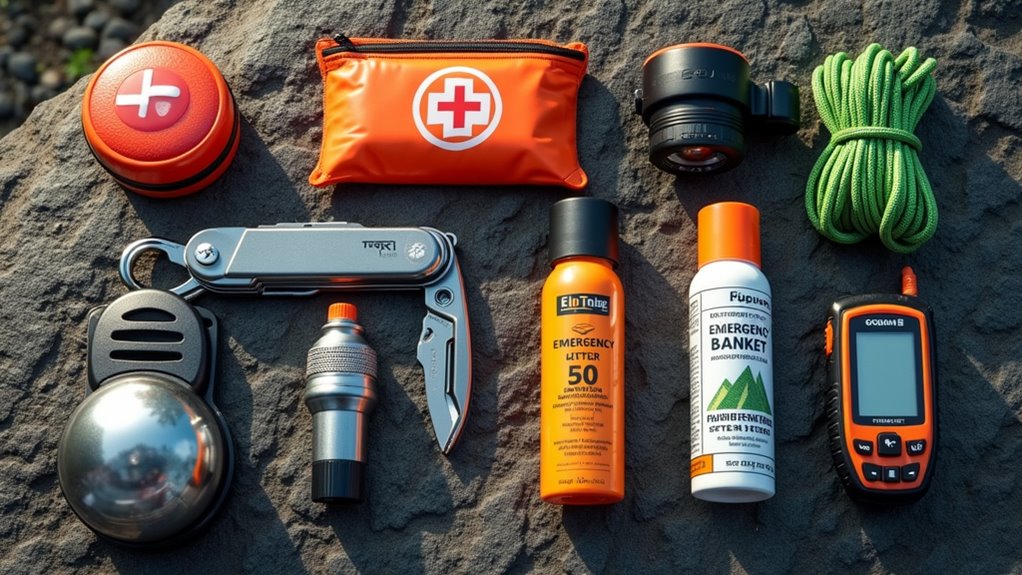
Gear up with these 12 essential camping safety items that could save your life when wilderness emergencies strike unexpectedly.
When you’re heading into the wilderness, you can’t predict what’ll go wrong—but you can prepare for it. The difference between a minor setback and a dangerous situation often comes down to having the right gear in your pack. Smart campers know that certain essential items can mean the difference between calling for help and becoming someone who needs rescuing. Here’s what you should never leave behind.
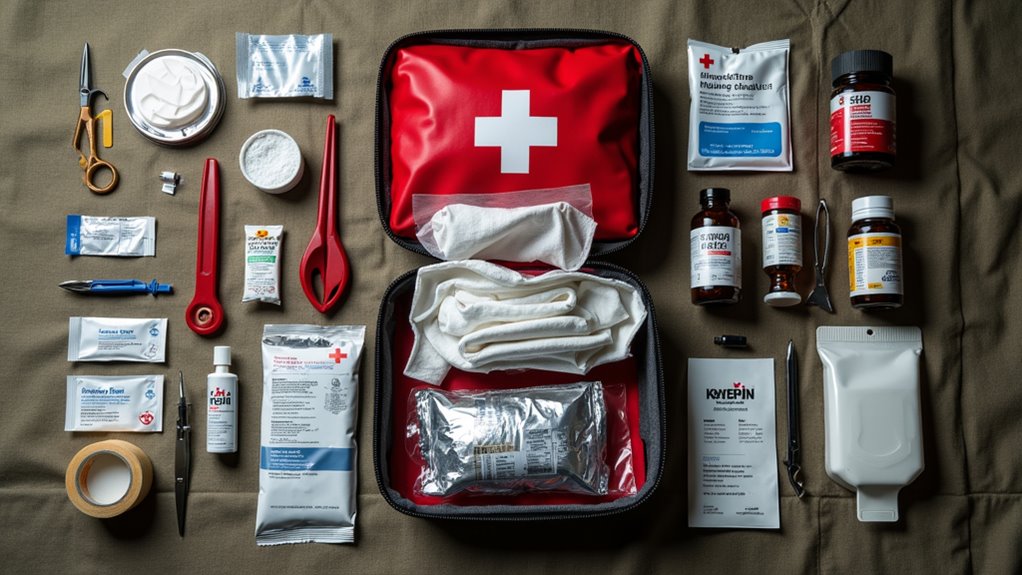
When you’re miles from the nearest hospital, a well-stocked first aid kit becomes your frontline defense against injuries and medical emergencies. Pack bandages in various sizes, antiseptic wipes, gauze pads, and medical tape for wound care.
Include pain relievers like ibuprofen and acetaminophen, plus any prescription medications you take regularly. Don’t forget tweezers for splinter removal, instant cold packs for sprains, and burn gel for cooking mishaps.
Add antihistamines for allergic reactions and anti-diarrheal medication for stomach troubles. Include a thermometer and emergency contact information.
Store everything in a waterproof container that’s easily accessible. Check expiration dates before each trip and replace items as needed. Following essential first aid tips will help ensure your camping adventure remains safe and enjoyable for everyone involved.
While a first aid kit handles medical emergencies, you’ll need reliable communication tools to call for help when situations exceed your abilities to manage alone. Cell phones work in many camping areas, but don’t count on consistent coverage in remote locations.
A satellite communicator is your most dependable backup. Devices like Garmin inReach or SPOT allow two-way messaging and emergency alerts from anywhere. They’re pricier than other options but worth the investment for serious backcountry trips.
Personal locator beacons (PLBs) send distress signals to search and rescue teams but only work for life-threatening emergencies.
Two-way radios help you communicate with your camping group within a limited range.
Always test your devices before departure and pack extra batteries. Register your trip details with someone reliable at home. Communication devices become especially critical when exploring dense rainforest hiking trails where terrain and vegetation can further limit signal reception.
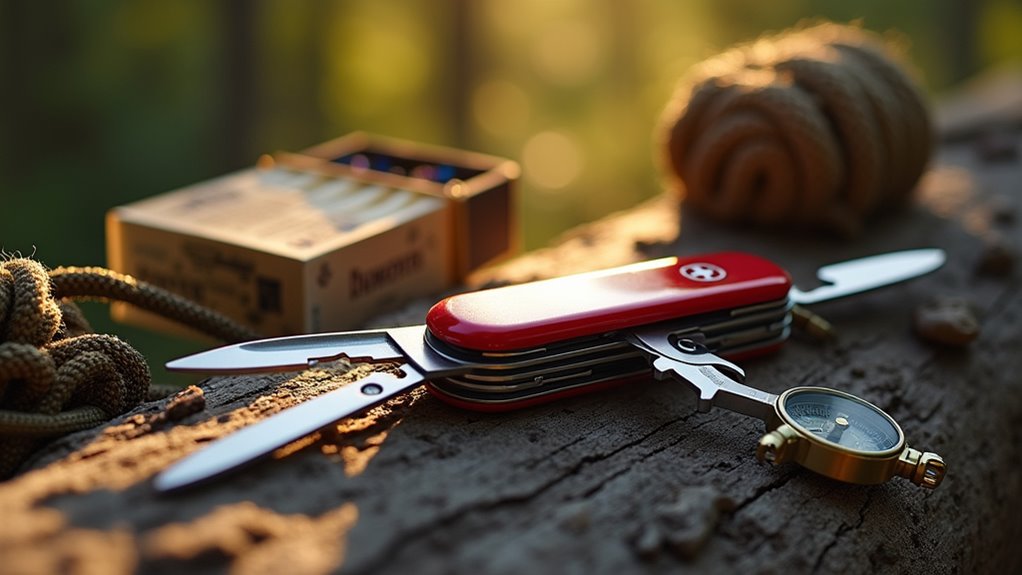
A quality multi-tool or Swiss Army knife serves as your portable workshop in the wilderness, consolidating dozens of essential functions into one compact device. You’ll find yourself reaching for it constantly—cutting rope, opening cans, preparing food, making repairs, or handling unexpected situations that demand precision tools.
Choose a model with sturdy construction and essential features like sharp blades, pliers, screwdrivers, scissors, and a can opener. Don’t get distracted by fancy gadgets you won’t use; focus on durability and practicality instead.
Keep your multi-tool easily accessible, either clipped to your belt or stored in an outer pocket. Regular maintenance guarantees it’ll perform when you need it most. Clean the joints, oil moving parts, and sharpen blades before each trip.
After setting up your shelter with camping hammocks, having your multi-tool within arm’s reach ensures you can quickly address any adjustments or repairs needed for a safe night’s rest.
Since darkness can transform even familiar terrain into a dangerous obstacle course, reliable lighting becomes your lifeline during nighttime camping adventures. You’ll need a dependable flashlight that won’t fail when you’re locating rocky paths or searching for supplies in your tent.
Choose a flashlight that meets these essential criteria:
Don’t forget extra batteries – they’re worthless if your light dies unexpectedly. Pack more than you think you’ll need, and consider bringing a backup flashlight or headlamp.
Test everything before your trip to avoid unpleasant surprises in the wilderness.
Proper lighting preparation is just one aspect of ensuring your family camping experience remains both safe and enjoyable throughout your outdoor adventure.
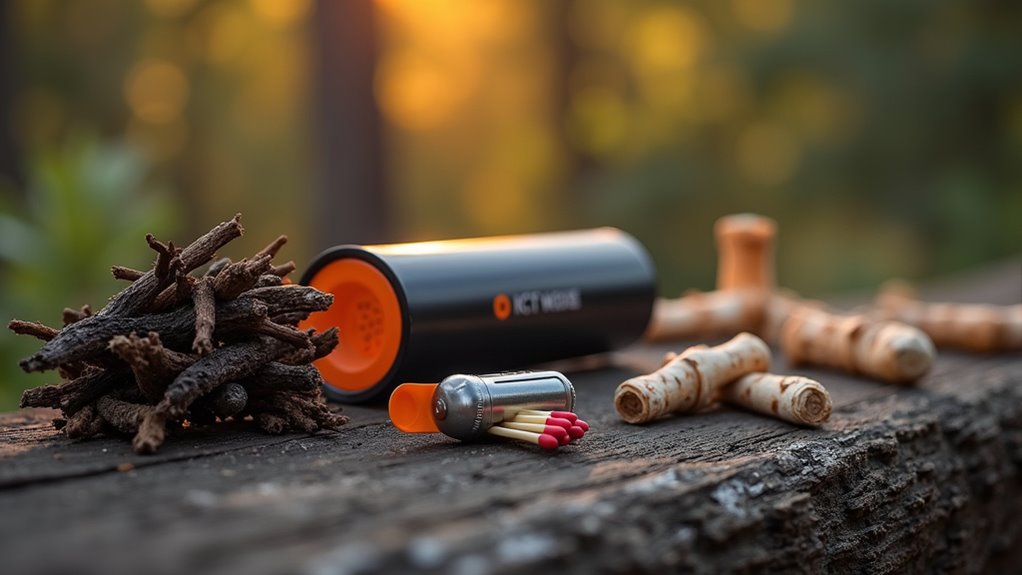
Because fire serves multiple critical functions at your campsite—from cooking meals to providing warmth and protection—you’ll want redundant methods for starting one reliably.
Pack at least three different fire-starting tools: waterproof matches, a quality lighter, and a ferrocerium rod with striker. Store matches in a watertight container and test your lighter’s fuel level before departing.
Don’t forget reliable tinder—dryer lint, petroleum jelly-soaked cotton balls, or commercial fire starters work excellently. Birch bark and dry pine needles make great natural alternatives.
Practice using your ferrocerium rod at home since it requires technique but works when wet.
Always carry backup options. Weather conditions can render one method useless, but having multiple fire-starting tools ensures you’ll create flame when needed most.
Remember that proper campfire safety practices are just as important as having the right equipment to start your fire.
How will you guarantee safe drinking water when natural sources may contain harmful bacteria, parasites, or chemical contaminants? You’ll need a reliable water purification system that goes beyond basic boiling.
Portable water filters remove most bacteria and parasites, while purification tablets handle viruses and remaining microorganisms. UV sterilizers offer another effective option, though they require battery power. Don’t rely on just one method—redundancy saves lives.
Essential purification tools include:
Always treat water from streams, lakes, and wells, even if they appear clean. Clear water doesn’t equal safe water. Test your purification system before heading out.
Remember that water conservation is equally important as purification, especially in remote areas where sources may be scarce or seasonal.
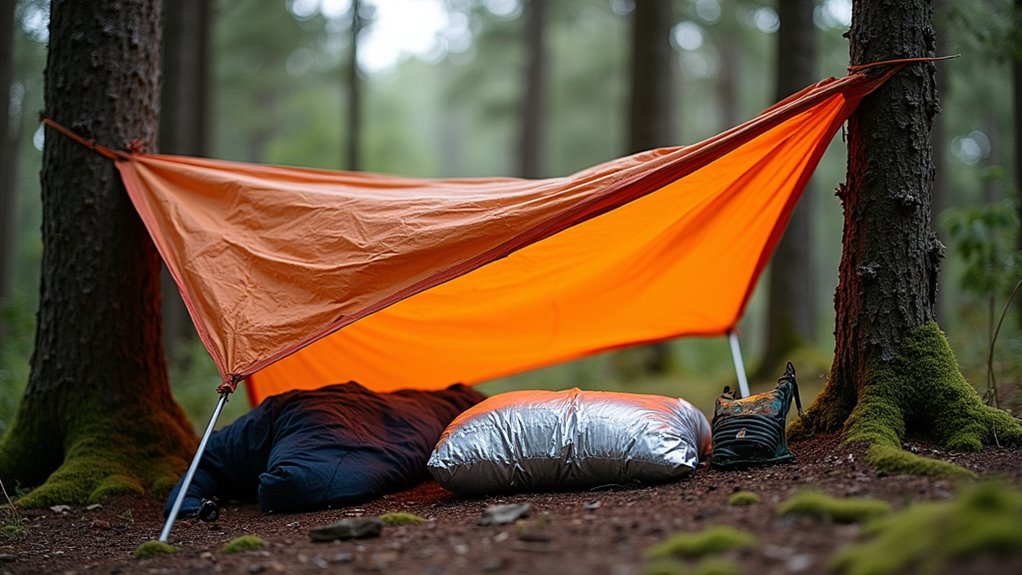
When unexpected weather strikes or your primary shelter fails, you’ll depend on emergency backup options to survive the night. Pack a lightweight tarp or emergency shelter as your backup plan. A quality tarp serves multiple purposes—it’ll provide overhead protection from rain, create windbreaks, or form ground cover beneath your sleeping area.
Choose ripstop nylon or polyethylene tarps that fold compact but offer reliable waterproofing. Include paracord or bungee cords for securing your shelter to trees or stakes. Practice basic tarp configurations like A-frame, lean-to, or diamond setups before your trip.
Emergency bivvy sacks work well for solo campers, reflecting body heat while blocking wind and moisture. Don’t skimp on this gear—hypothermia kills faster than dehydration in survival situations. Having reliable emergency shelter also ensures your family camping activities can continue safely even when weather conditions become challenging.
While your smartphone’s GPS works fine in populated areas, you can’t rely on it when you’re deep in the wilderness where cell towers don’t reach. That’s why carrying traditional navigation tools is essential for your safety.
A reliable compass and detailed topographic map should be your primary navigation backup. Learn how to use them together before you head out – it’s a skill that could save your life.
Consider these additional navigation essentials:
Don’t forget to tell someone your planned route and expected return time. Even with the best navigation tools, having people who know where you’re headed provides an extra safety net.
In challenging terrain like the Himalayas, proper navigation becomes even more critical since getting lost can expose you to dangerous encounters with wild animals that inhabit these remote regions.
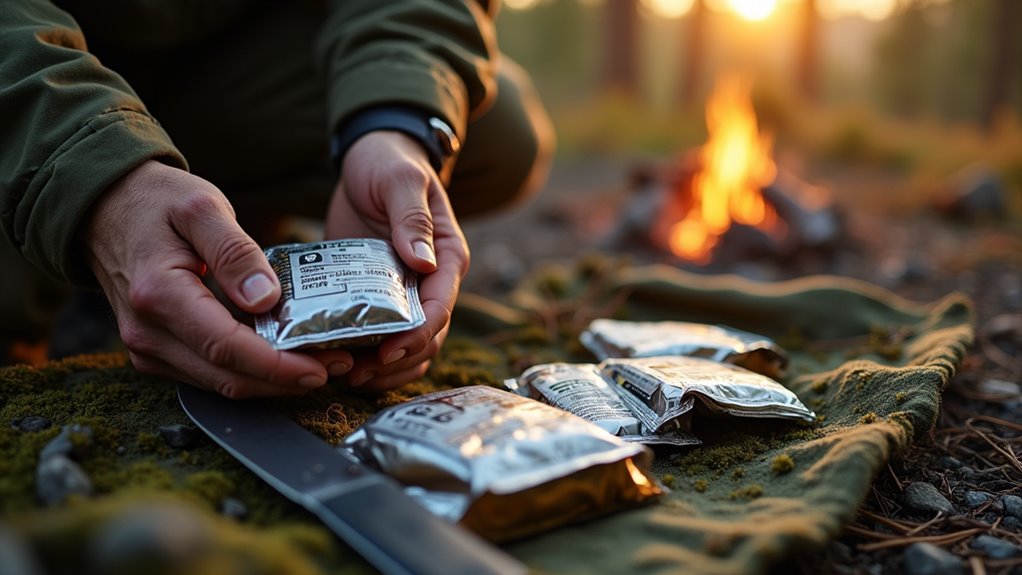
After sorting out your navigation gear, you’ll want to pack emergency food that won’t spoil and doesn’t require cooking. Energy bars, trail mix, and nuts provide quick calories when you’re exhausted or lost. Dried fruits offer natural sugars for instant energy boosts.
Pack at least three days’ worth of non-perishable food beyond your regular meals. Canned goods work if you’ve got a can opener, but they’re heavy. Dehydrated meals are lighter but need water. Peanut butter packets, crackers, and jerky are reliable standbys that won’t let you down.
Store everything in waterproof containers or sealed bags. Check expiration dates before each trip and rotate your emergency stash regularly. You’ll never regret having extra food when hunger strikes unexpectedly.
These same principles apply to winter RV camping, where having backup food supplies becomes even more critical in harsh weather conditions.
Since weather can shift from sunny to stormy in minutes, you’ll need gear that keeps you dry and warm no matter what nature throws at you.
Your rain jacket should be waterproof, not just water-resistant. There’s a big difference when you’re caught in a downpour. Pack lightweight rain pants too – wet legs make for miserable hiking.
Don’t forget these essential items:
A quality tarp provides versatile shelter for cooking or waiting out storms. Choose one that’s larger than your tent’s footprint. Pack paracord for securing it properly.
Weather protection isn’t optional – it’s what separates safe campers from rescue statistics. When planning to explore trails from your campsite, consider that hiking conditions can change rapidly and require additional weather preparedness beyond your base camp setup.
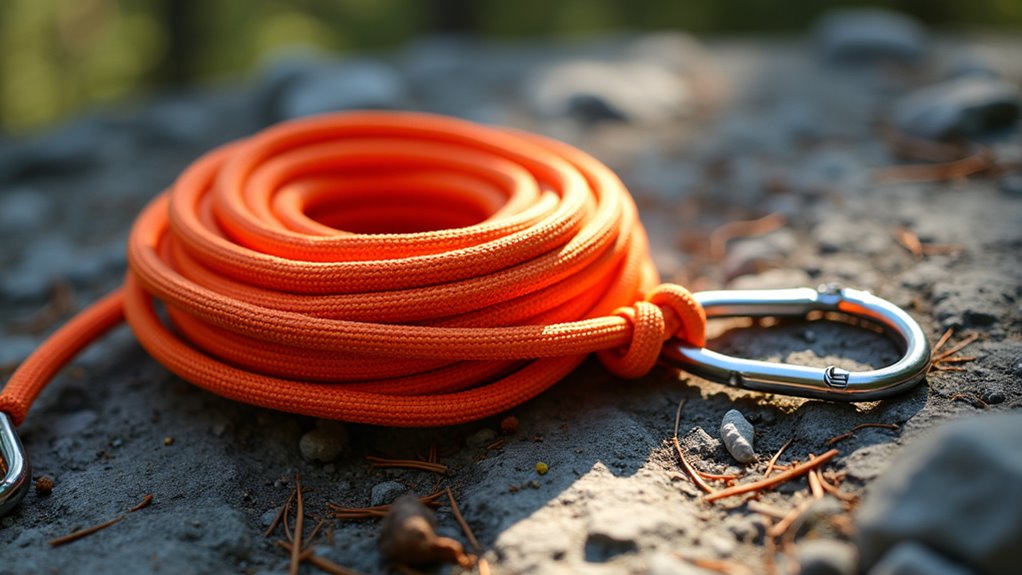
Speaking of paracord for securing tarps, this versatile rope deserves its own spotlight in your camping kit. You’ll find countless uses for 50-100 feet of quality paracord beyond just securing shelter.
It’s perfect for hanging bear bags, creating clotheslines, repairing torn gear, or fashioning emergency restraints.
Choose genuine 550 paracord with seven inner strands – you can unravel these for fishing line, sutures, or snares if needed. The outer sheath works great for larger tasks like securing loads or building shelters.
Keep your paracord tangle-free by wrapping it properly or using a paracord dispenser. Don’t skimp on quality here – cheap rope fails when you need it most.
Practice basic knots like bowline, clove hitch, and trucker’s hitch before your trip.
You can also use paracord to secure your air mattress to prevent it from sliding around inside your tent during the night.
What threats might you encounter in the wilderness that require more than just preparation and awareness? While most camping experiences are peaceful, you’ll want personal protection options for unexpected situations involving aggressive wildlife or dangerous individuals.
Consider carrying these essential protection items:
You might also consider a knife designed for protection, though it requires proper training.
Whatever you choose, make sure you’re comfortable using it and understand local regulations. Some areas restrict certain items, so research beforehand.
If you’re planning to hike famous trails like Scotland’s West Highland Way, extra safety preparation becomes even more important due to remote wilderness conditions.
You’ve got your safety arsenal mapped out—now you’re ready to dance with the wilderness instead of wrestling it. These nine essentials aren’t just gear; they’re your lifeline when Mother Nature throws her curveballs. Pack ’em, check ’em, and trust ’em. Because out there, preparation’s the difference between writing epic stories around the campfire and becoming one yourself. Stay smart, stay safe, and let adventure find you ready.